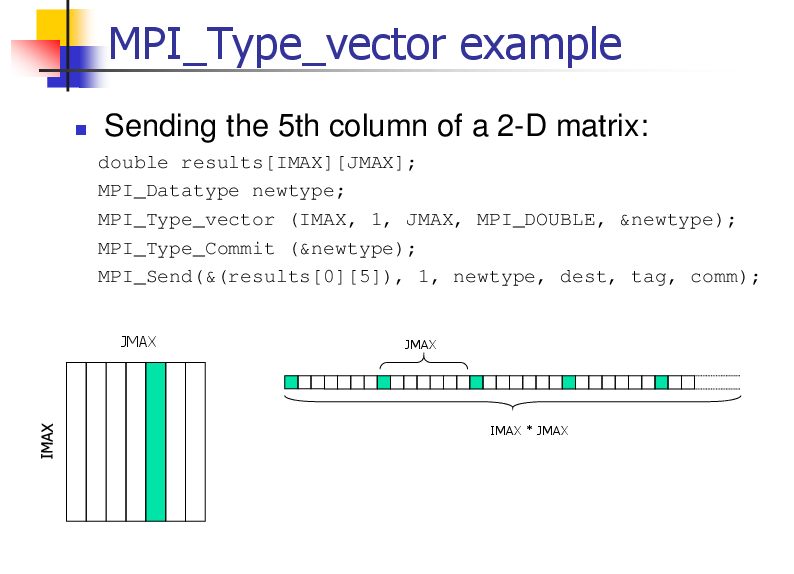Párhuzamos és Grid rendszerek 6. előadás
Letöltés
- Nyomtatáshoz, 3 dia/lap (529K)
- Nyomtatáshoz, 6 dia/lap (526K)
- Képernyőre, 1 dia/lap (színes) (538K)
- E-könyv olvasóhoz, 1 dia/lap (526K)
2.
Message Passing M M M ... P P network P Each processor runs a process Processes communicate by exchanging messages They cannot share memory in the sense that they cannot address the same memory cells The above is a programming model and things may look different in the actual implementation (e.g., MPI over Shared Memory) Message Passing is popular because it is general: Pretty much any distributed system works by exchanging messages, at some level Distributed- or shared-memory multiprocessors, networks of workstations, uniprocessors It is not popular because it is easy (it’s not)
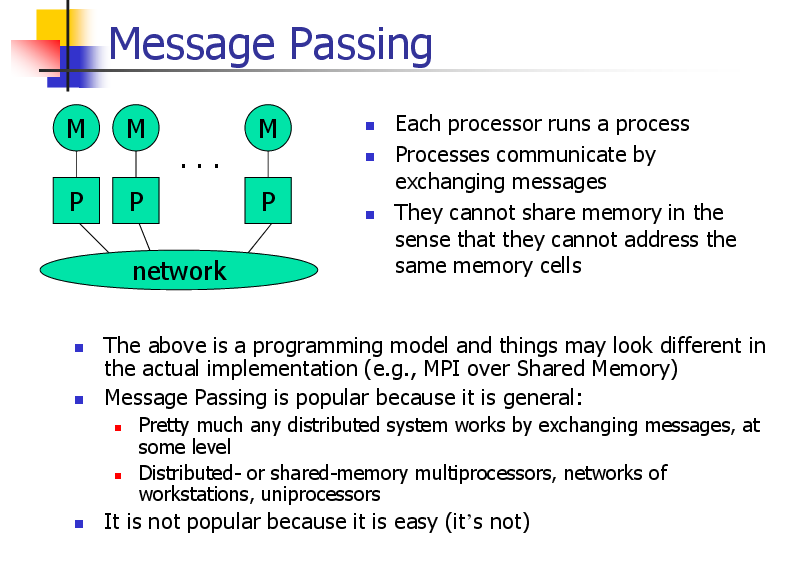
3.
MPI Concepts Fixed number of processors When launching the application one must specify the number of processors to use, which remains unchanged throughout execution Communicator Abstraction for a group of processes that can communicate A process can belong to multiple communicators Makes is easy to partition/organize the application in multiple layers of communicating processes Default and global communicator: MPI_COMM_WORLD Process Rank The index of a process within a communicator Typically user maps his/her own virtual topology on top of just linear ranks ring, grid, etc.
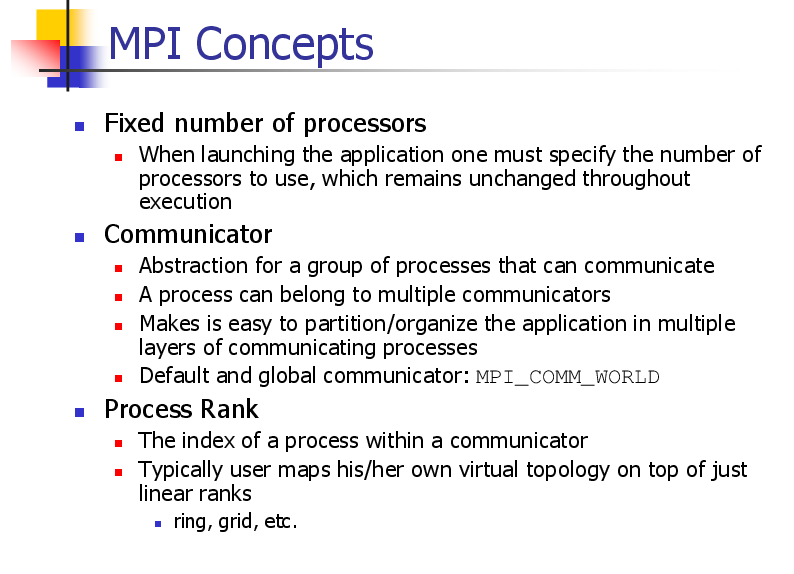
4.
MPI Communicators User-created Communicator MPI_COMM_WORLD 0 1 2 5 6 7 0 10 11 1 01 12 3 15 3 16 8 9 2 14 13 4 17 6 4 5 19 18 7 8 User-created Communicator

5.
A First MPI Program #include <unistd.h> #include <mpi.h> int main(int argc, char **argv) { int my_rank, n; Has to be called first, and once char hostname[128]; MPI_init(&argc,&argv); MPI_Comm_rank(MPI_COMM_WORLD,&my_rank); MPI_Comm_size(MPI_COMM_WORLD,&n); gethostname(hostname,128); if (my_rank == 0) { /* master */ printf(“I am the master: %s\n”,hostname); } else { /* worker */ printf(“I am a worker: %s (rank=%d/%d)\n”, hostname,my_rank,n-1); } MPI_Finalize(); exit(0); Has to be called last, and once }
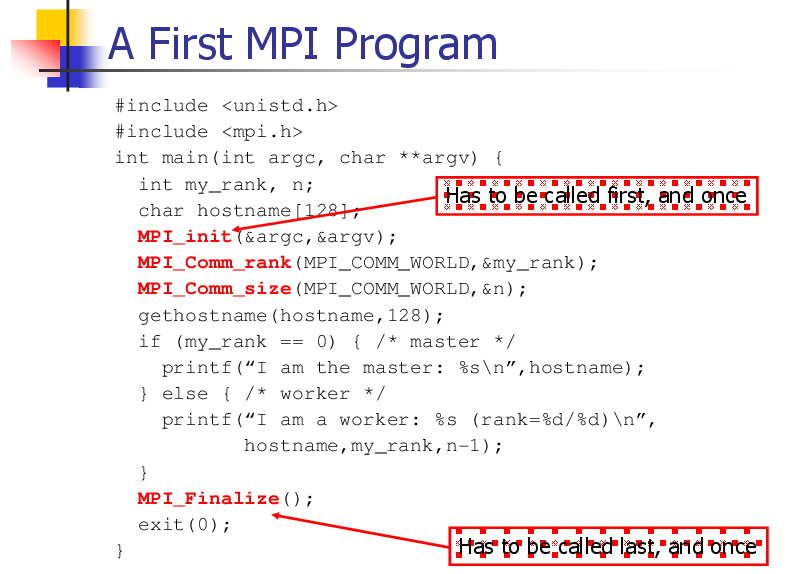
6.
Compiling/Running it Link with libmpi.a Run with mpirun % mpirun -np 4 my_program <args> requests 4 processors for running my_program with command-line arguments see the mpirun man page for more information in particular the -machinefile option that is used to run on a network of workstations Some systems just run all programs as MPI programs and no explicit call to mpirun is actually needed Previous example program: % mpirun -np 3 -machinefile hosts my_program I am the master: somehost1 I am a worker: somehost2 (rank=2/2) I am a worker: somehost3 (rank=1/2) (stdout/stderr redirected o the process calling mpirun)
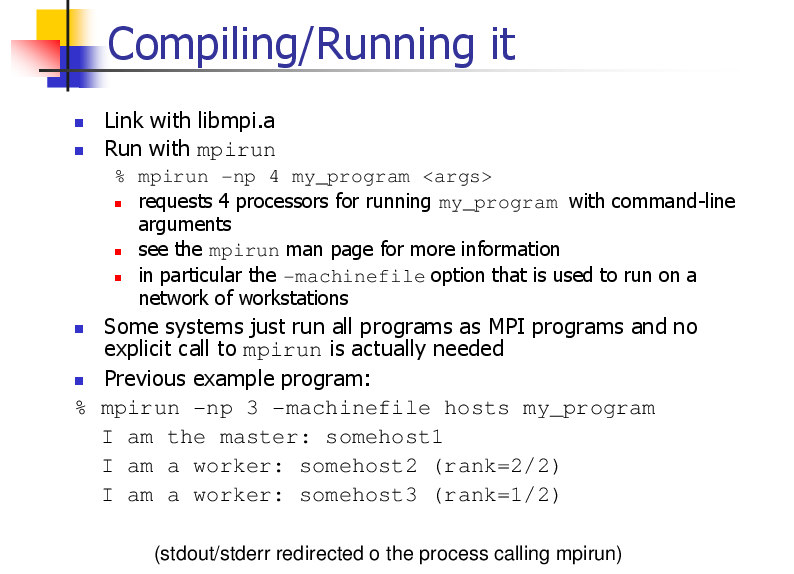
7.
Point-to-Point Communication M M P P Data to be communicated is described by three things: address data type of the message length of the message Involved processes are described by two things communicator rank Message is identified by a “tag” (integer) that can be chosen by the user
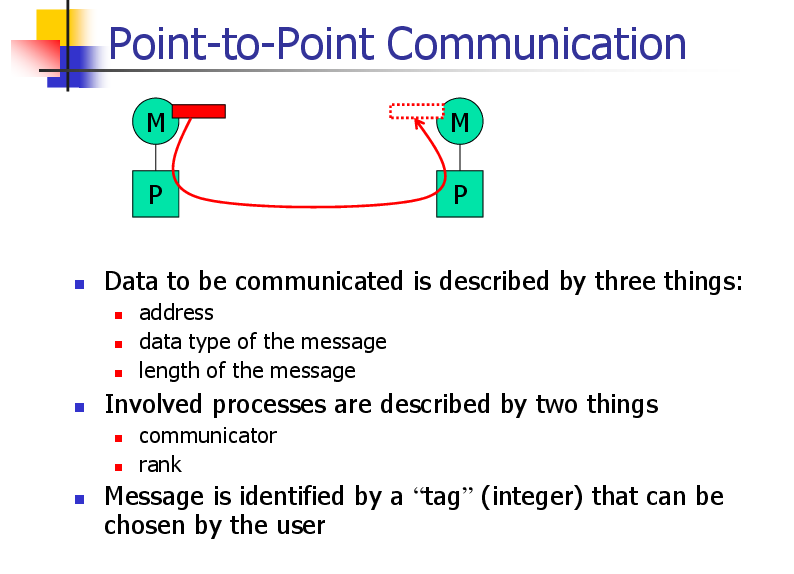
8.
Point-to-Point Communication Two modes of communication: Synchronous: Communication does not complete until the message has been received Asynchronous: Completes as soon as the message is “on its way”, and hopefully it gets to destination MPI provides four versions synchronous, buffered, standard, ready

9.
Synchronous/Buffered sending in MPI Synchronous with MPI_Ssend The send completes only once the receive has succeeded copy data to the network, wait for an ack The sender has to wait for a receive to be posted No buffering of data Buffered with MPI_Bsend The send completes once the message has been buffered internally by MPI Buffering incurs an extra memory copy Doe not require a matching receive to be posted May cause buffer overflow if many bsends and no matching receives have been posted yet

10.
Standard/Ready Send Standard with MPI_Send Up to MPI to decide whether to do synchronous or buffered, for performance reasons The rationale is that a correct MPI program should not rely on buffering to ensure correct semantics Ready with MPI_Rsend May be started only if the matching receive has been posted Can be done efficiently on some systems as no handshaking is required
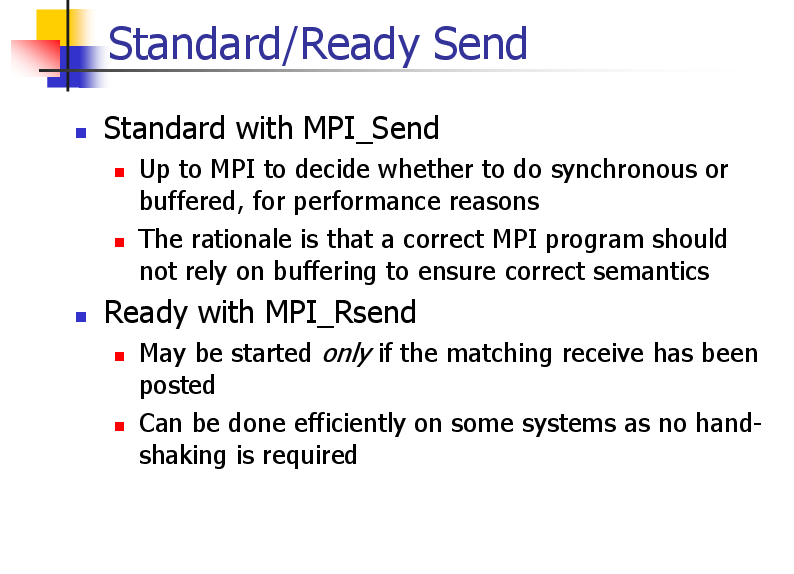
11.
Example: Sending and Receiving #include <unistd.h> #include <mpi.h> int main(int argc, char **argv) { int i, my_rank, nprocs, x[4]; MPI_Init(&argc,&argv); MPI_Comm_rank(MPI_COMM_WORLD,&my_rank); destination if (my_rank == 0) { /* master */ and x[0]=42; x[1]=43; x[2]=44; x[3]=45; source MPI_Comm_size(MPI_COMM_WORLD,&nprocs); for (i=1;i<nprocs;i++) MPI_Send(x,4,MPI_INT,i,0,MPI_COMM_WORLD); user-defined } else { /* worker */ tag MPI_Status status; MPI_Recv(x,4,MPI_INT,0,0,MPI_COMM_WORLD,&status); } MPI_Finalize(); Max number of Can be examined via calls exit(0); elements to receive like MPI_Get_count(), etc. }
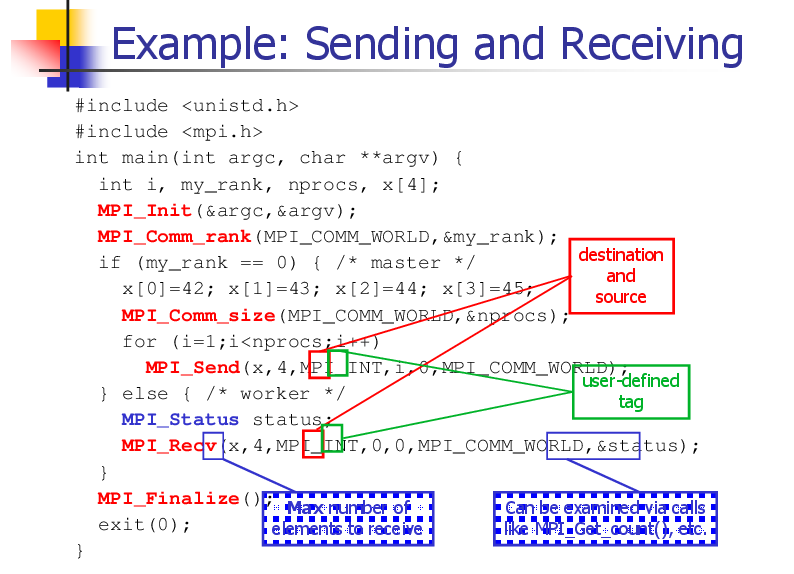
12.
Non-blocking Communication MPI_Issend, MPI_Ibsend, MPI_Isend, MPI_Irsend, MPI_Irecv MPI_Request request; MPI_Isend(&x,1,MPI_INT,dest,tag,communicator,&request); MPI_Irecv(&x,1,MPI_INT,src,tag,communicator,&request); Functions to check on completion: MPI_Wait, MPI_Test, MPI_Waitany, MPI_Testany, MPI_Waitall, MPI_Testall, MPI_Waitsome, MPI_Testsome. MPI_Status status; MPI_Wait(&request, &status) /* block */ MPI_Test(&request, &status) /* doesn’t block */
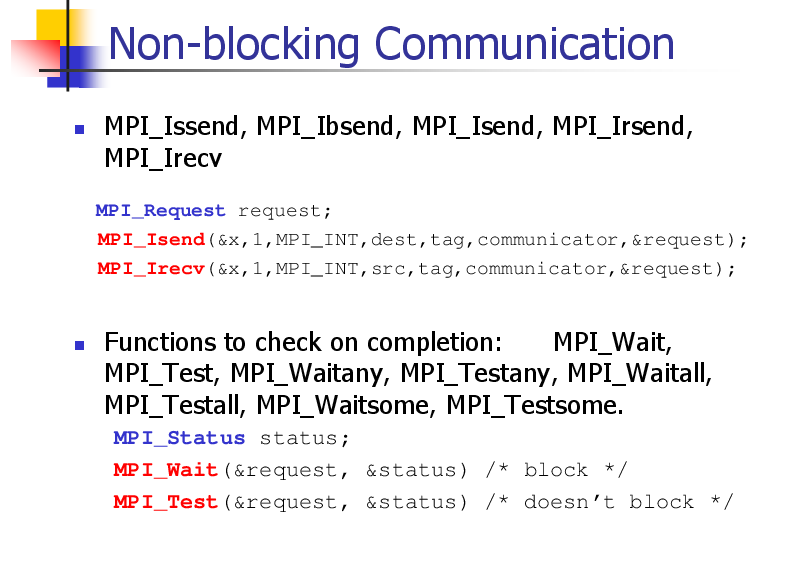
13.
Collective Communication Operations that allow more than 2 processes to communicate simultaneously barrier broadcast reduce All these can be built using point-to-point communications, but typical MPI implementations have optimized them, and it’s a good idea to use them In all of these, all processes place the same call (in good SPMD fashion), although depending on the process, some arguments may not be used
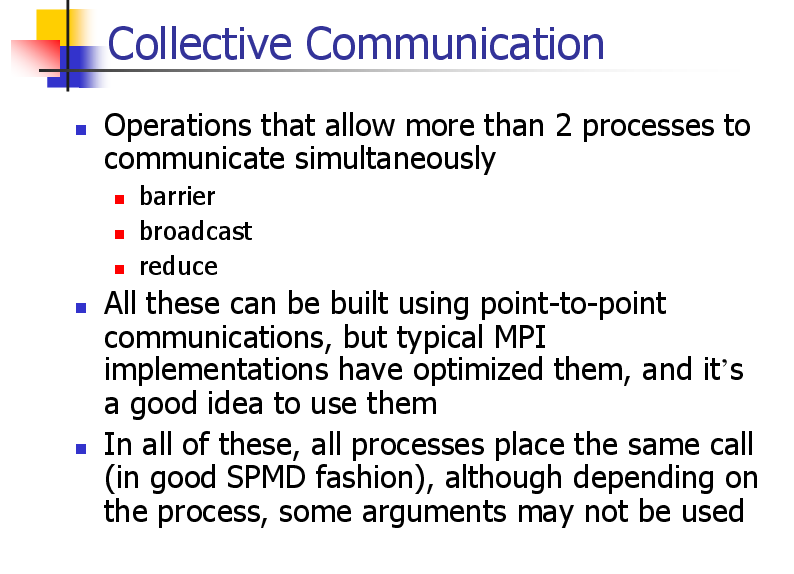
14.
Barrier Synchronization of the calling processes the call blocks until all of the processes have placed the call No data is exchanged ... MPI_Barrier(MPI_COMM_WORLD) ...
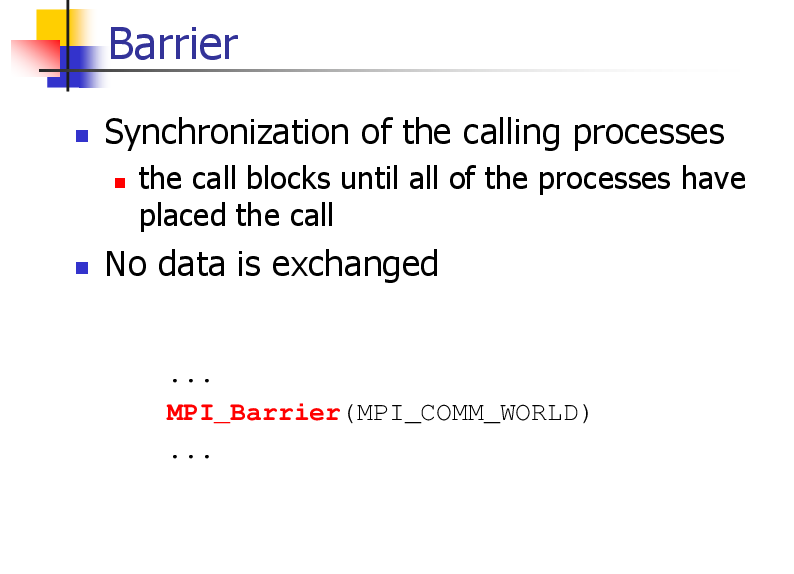
15.
Broadcast One-to-many communication Note that multicast can be implemented via the use of communicators (i.e., to create processor groups) ... MPI_Bcast(x, 4, MPI_INT, 0, MPI_COMM_WORLD) ... Rank of the root
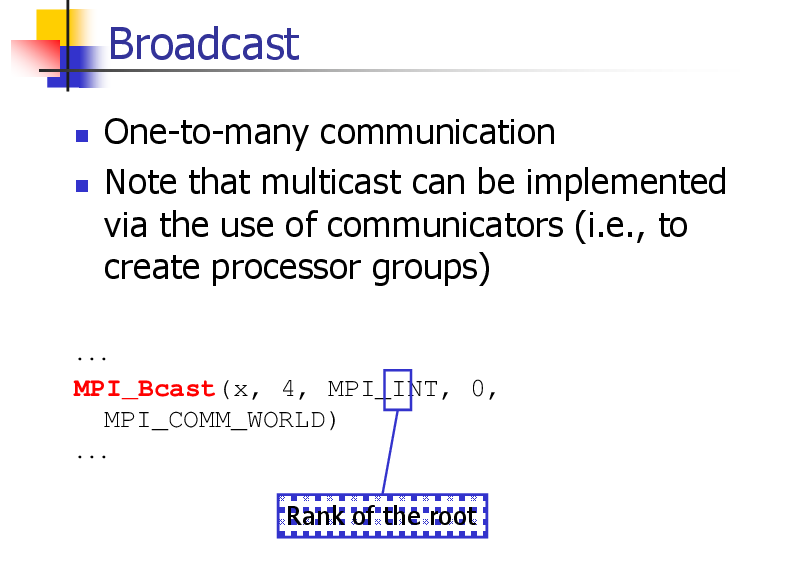
16.
Scatter One-to-many communication Not sending the same message to all root . . . destinations ... MPI_Scatter(x, 100, MPI_INT, y, 100, MPI_INT, 0, MPI_COMM_WORLD) ... Send buffer Receive buffer Data to send to each Data to receive Rank of the sending proc

17.
Gather Many-to-one communication Not sending the same message to the root . . . sources root ... MPI_Gatger(x, 100, MPI_INT, y, 100, MPI_INT, 0, MPI_COMM_WORLD) ... Send buffer Receive buffer Data to send from each Data to receive Rank of the receiving proc.
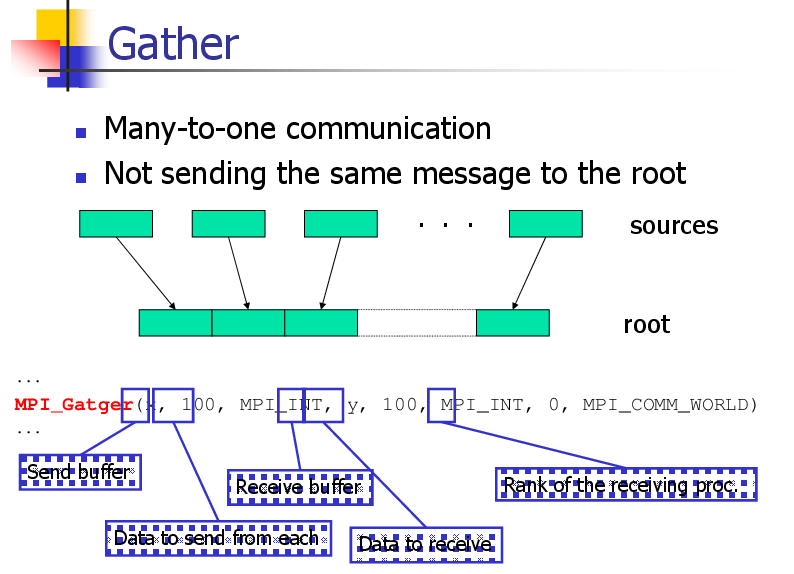
18.
Gather-to-all Many-to-many communication Each process sends the same message to all Different Processes send different messages . . . . . . ... MPI_Allgather(x, 100, MPI_INT, y, 100, MPI_INT, MPI_COMM_WORLD) ... Send buffer Data to receive Data to send to each Receive buffer
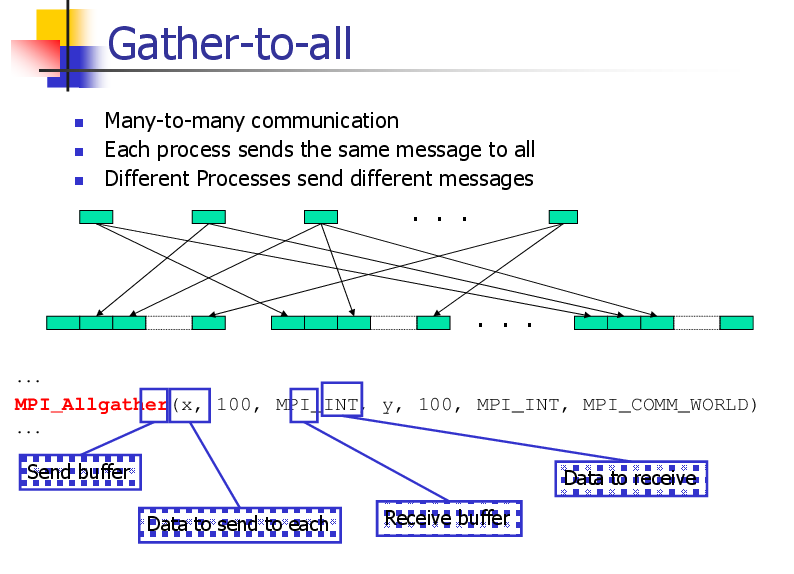
19.
All-to-all Many-to-many communication Each process sends a different message to each other process . . . Block i from proc j goes to block j on proc i . . . ... MPI_Alltoall(x, 100, MPI_INT, y, 100, MPI_INT, MPI_COMM_WORLD) ... Send buffer Data to receive Data to send to each Receive buffer
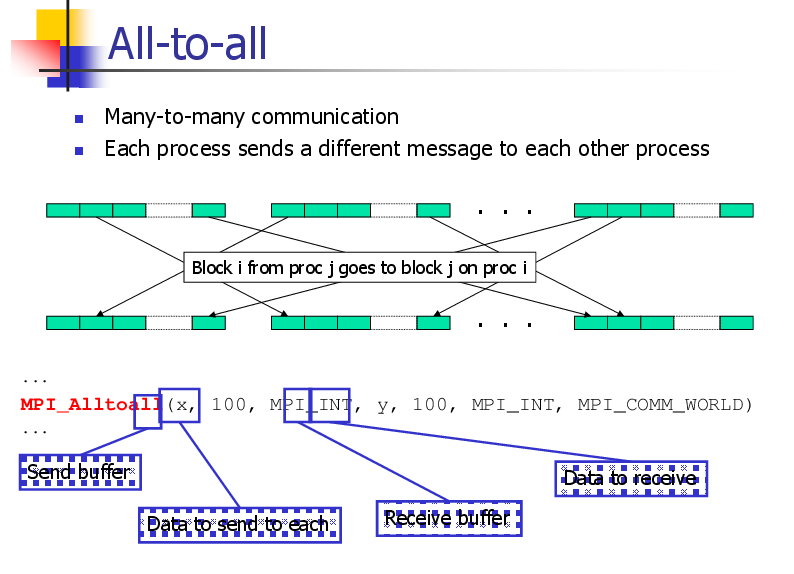
20.
Reduction Operations Used to compute a result from data that is distributed among processors often what a user wants to do anyway so why not provide the functionality as a single API call rather than having people keep re-implementing the same things Predefined operations: MPI_MAX, MPI_MIN, MPI_SUM, etc. Possibility to have user-defined operations
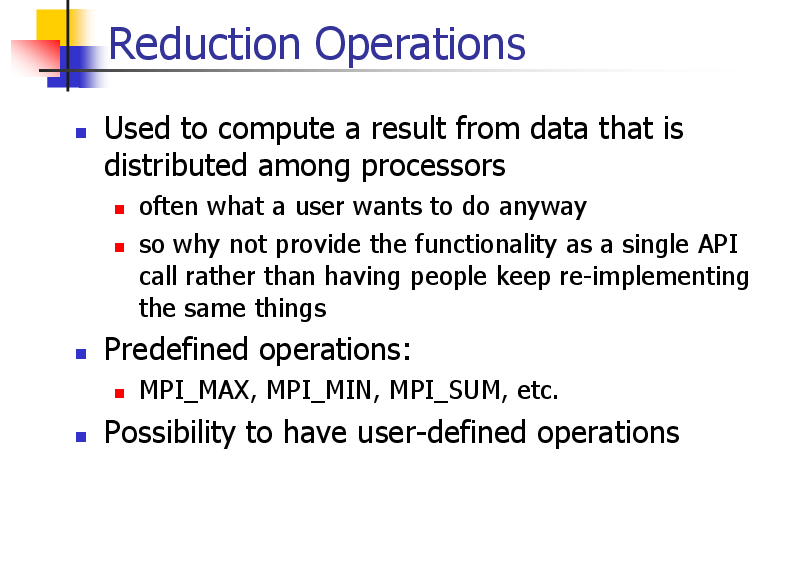
21.
MPI_Reduce, MPI_Allreduce MPI_Reduce: result is sent out to the root the operation is applied element-wise for each element of the input arrays on each processor MPI_Allreduce: result is sent out to everyone ... MPI_Reduce(x, r, 10, MPI_INT, MPI_MAX, 0, MPI_COMM_WORLD) ... input array output array array size root ... MPI_Allreduce(x, r, 10, MPI_INT, MPI_MAX, MPI_COMM_WORLD) ...
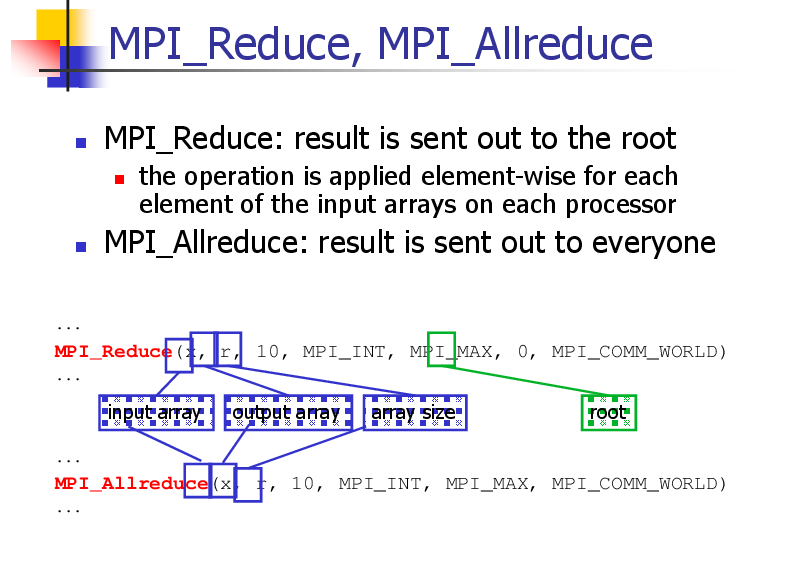
22.
MPI_Reduce example MPI_Reduce(sbuf,rbuf,6,MPI_INT,MPI_SUM,0,MPI_COMM_WORLD) sbuf P0 3 4 2 8 12 1 rbuf P1 5 2 5 1 7 11 P2 2 4 4 10 4 5 P3 1 6 9 3 1 1 P0 11 16 20 22 24 18
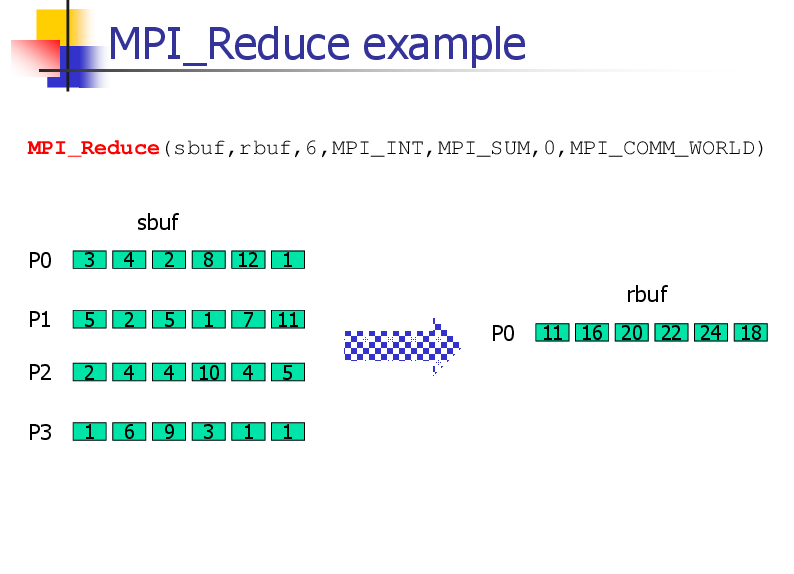
23.
MPI_Scan: Prefix reduction process i receives data reduced on process 0 to i. rbuf sbuf P0 3 4 2 8 12 1 P0 3 4 2 8 12 P1 5 2 5 1 7 11 P1 8 6 7 9 19 12 P2 2 4 4 10 4 5 P2 10 10 11 19 23 17 P3 1 6 9 3 1 1 P3 11 16 12 22 24 18 1 MPI_Scan(sbuf,rbuf,6,MPI_INT,MPI_SUM,MPI_COMM_WORLD)
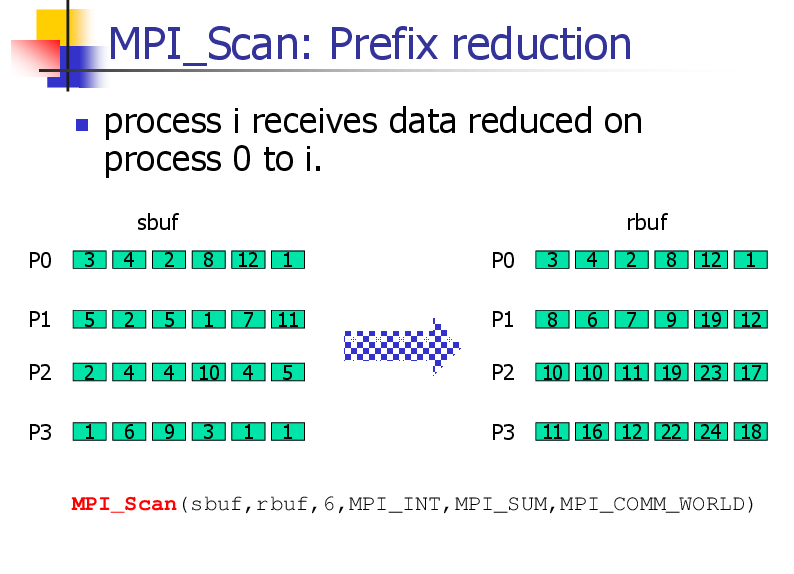
24.
User-defined reduce operations MPI_Op_create(MPI_User_function *function, int commute, MPI_Op *op) pointer to a function with a specific prototype commute (0 or 1) allows for optimization if true typedef void MPI_User_function(void *a, void *b, int *len, MPI_Datatype *datatype); b[i] = a[i] op b[i], for i=0,...,len-1
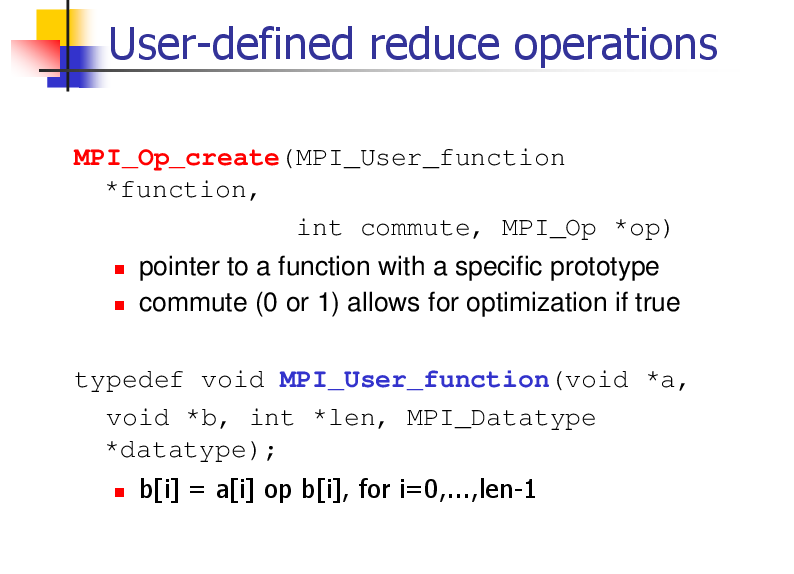
25.
MPI_Op_create example void myfunc(void *a, void *b, int *len, MPI_Datatype *dtype) { int i; for (i = 0; i < *len; ++i) ((int*)b)[i] = ((int*)b)[i] + ((int*)a)[i]; } int main(int argc, char *argv[]) { int myrank, nprocs, sendbuf, recvbuf; MPI_Op myop; MPI_Init(&argc, &argv); MPI_Comm_size(MPI_COMM_WORLD, &nprocs); MPI_Comm_rank(MPI_COMM_WORLD, &myrank); MPI_Op_create(myfunc, 1, &myop); sendbuf = 2*myrank+1; // odd numbers MPI_Reduce(&sendbuf, &recvbuf, 1, MPI_INT, myop, 0, MPI_COMM_WORLD); if(myrank == 0) printf("%d^2 = %d\n", nprocs,
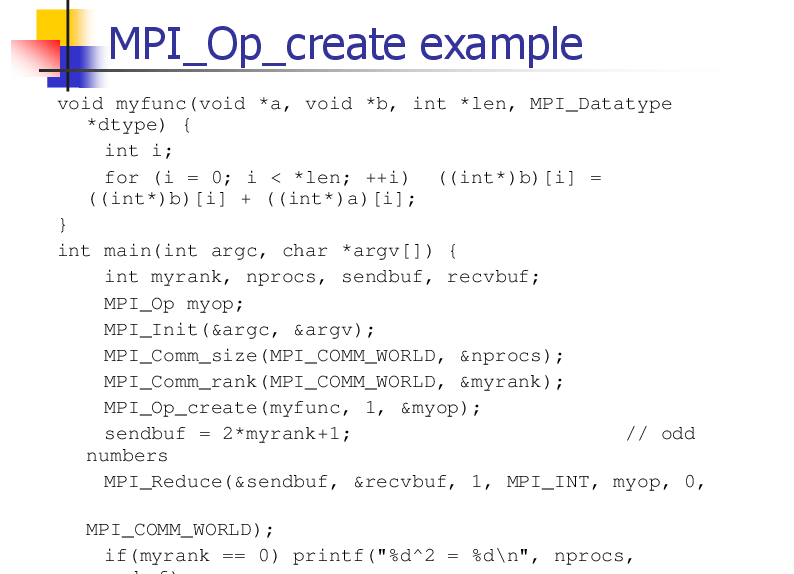
26.
More Advanced Messages Regularly strided data Blocks/Elements of a matrix Data structure struct { int a; double b; } A set of variables int a; double b; int x[12];
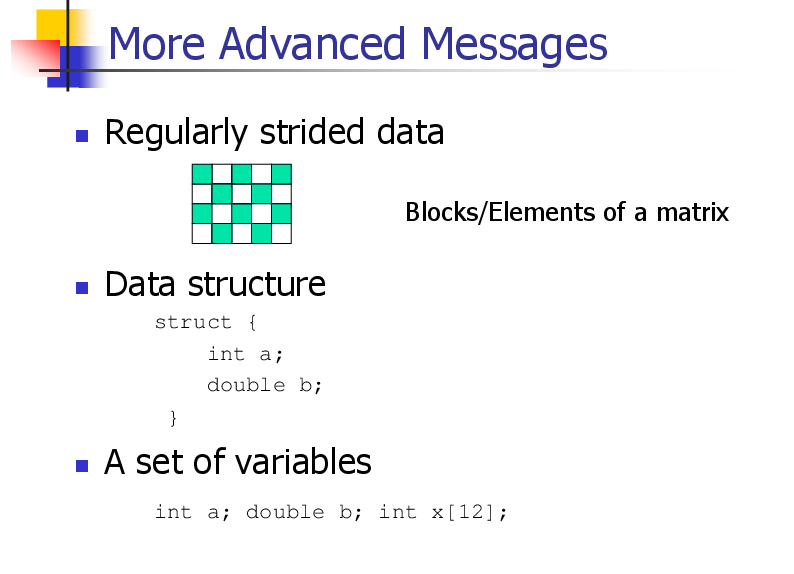
27.
Derived Data Types A data type is defined by a “type map” set of <type, displacement> pairs Created at runtime in two phases Construct the data type from existing types Commit the data type before it can be used Simplest constructor: contiguous type int MPI_Type_contiguous(int count, MPI_Datatype oldtype, MPI_Datatype *newtype)
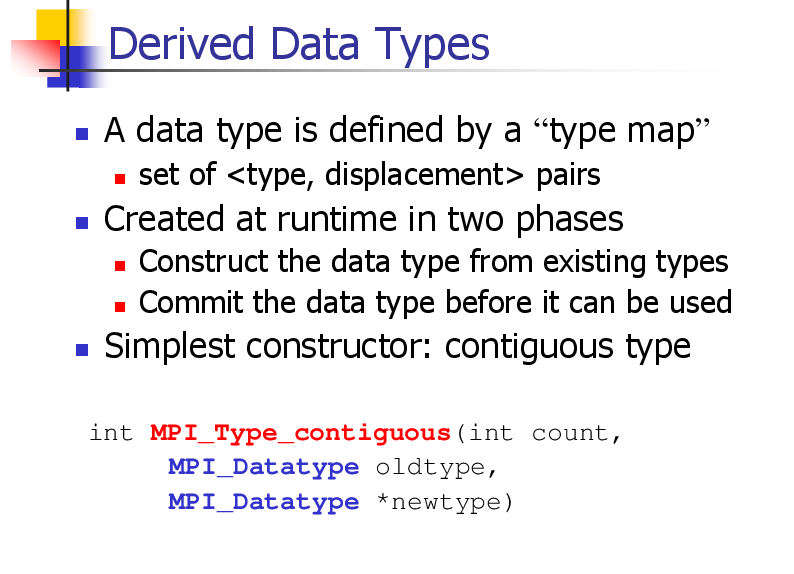
28.
MPI_Type_contiguous example int buffer[100]; MPI_Datatype chvec; MPI_Type_contiguous(20, MPI_CHAR, &chvec); MPI_Type_commit(&chvec); ... MPI_Send(buffer,1,chvec,1,44,MPI_COMM_WOR LD); MPI_Type_free(&chvec);
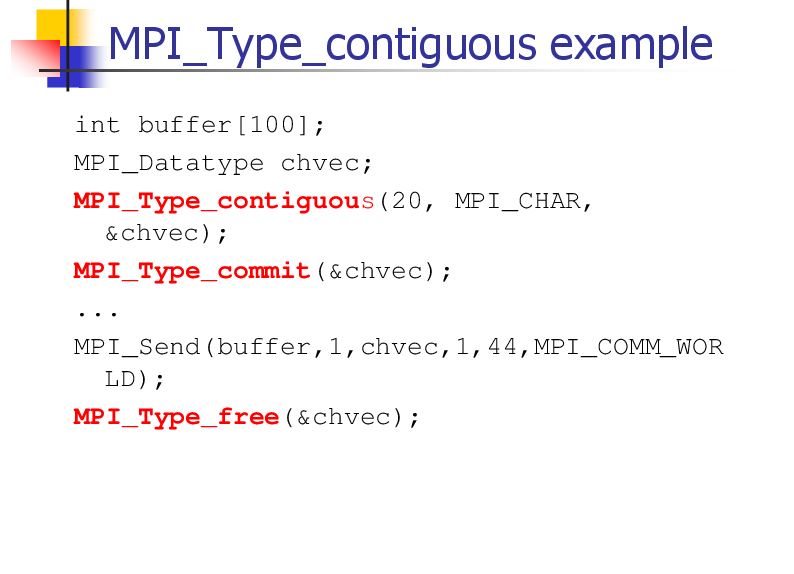
29.
MPI_Type_indexed() int MPI_Type_indexed(int count, int *array_of_blocklengths, int *array_of_displacements, MPI_Datatype oldtype, MPI_Datatype *newtype) len[0] Len[1]
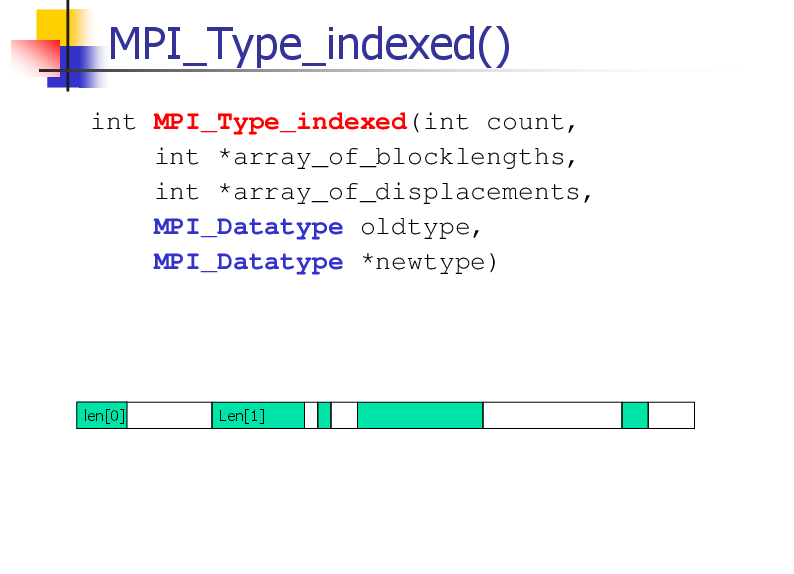
30.
MPI_Type_indexed example int vector[4][3] = { 11, 12, 13, 21, 22, 23, 31, 32, 33, 41, 42, 43 }; int wvector[4][3] = { 0 }; int blocklengths[2] = {2, 2}; int displacements[2] = {4, 10}; int rank; MPI_Datatype mytype; MPI_Status mystatus; MPI_Init(&argc, &argv); MPI_Type_indexed(4, blocklengths, displacements, MPI_INT, &mytype); MPI_Type_commit(&mytype); MPI_Comm_rank(MPI_COMM_WORLD, &rank); if (rank == 0) MPI_Send(vector, 1, mytype, 1, 0, MPI_COMM_WORLD); else { MPI_Recv(wvector, 1, mytype, 0, 0, MPI_COMM_WORLD, &mystatus); for (i = 0; i < 4; i++) { printf("\n"); for (j=0; j < 3; j++) printf("%02d ",
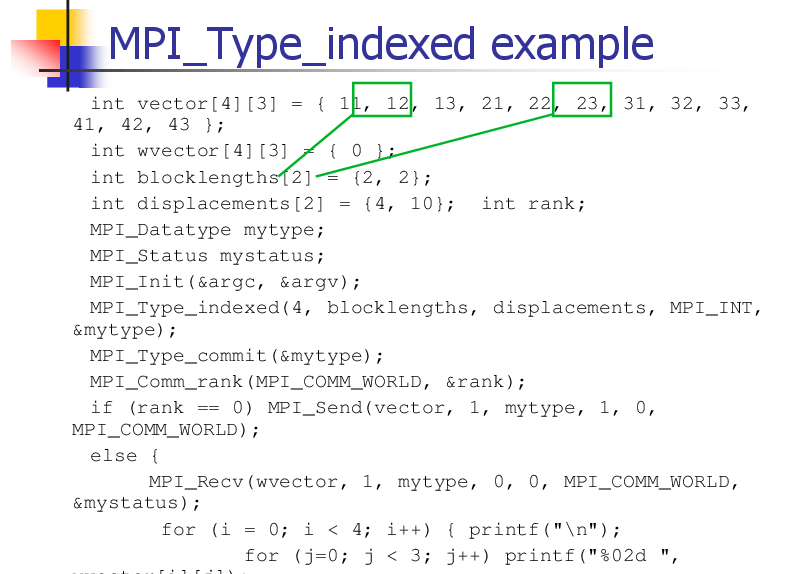
31.
MPI_Type_struct() int MPI_Type_struct(int count, int *array_of_blocklengths, MPI_Aint *array_of_displacements, MPI_Datatype *array_of_types, MPI_Datatype *newtype) MPI_INT MPI_DOUBLE My_weird_type
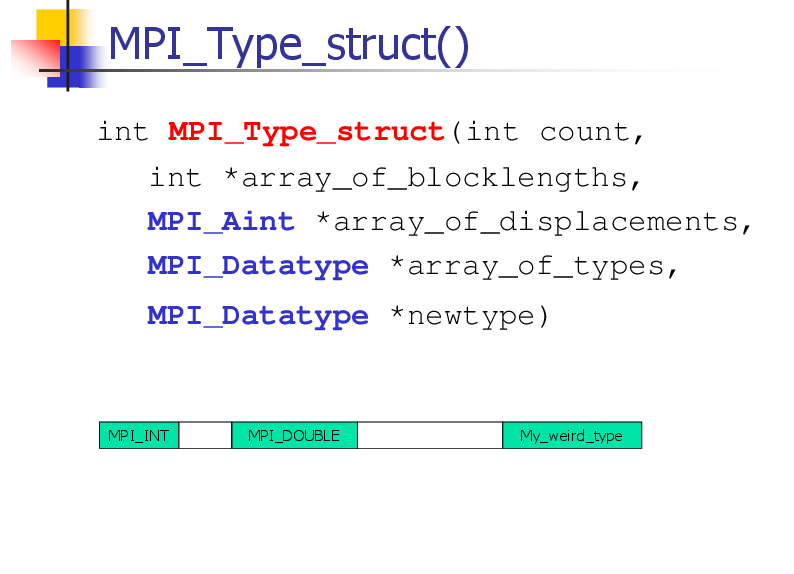
32.
MPI_Type_vector example Sending the 5th column of a 2-D matrix: double results[IMAX][JMAX]; MPI_Datatype newtype; MPI_Type_vector (IMAX, 1, JMAX, MPI_DOUBLE, &newtype); MPI_Type_Commit (&newtype); MPI_Send(&(results[0][5]), 1, newtype, dest, tag, comm); JMAX JMAX IMAX * JMAX
